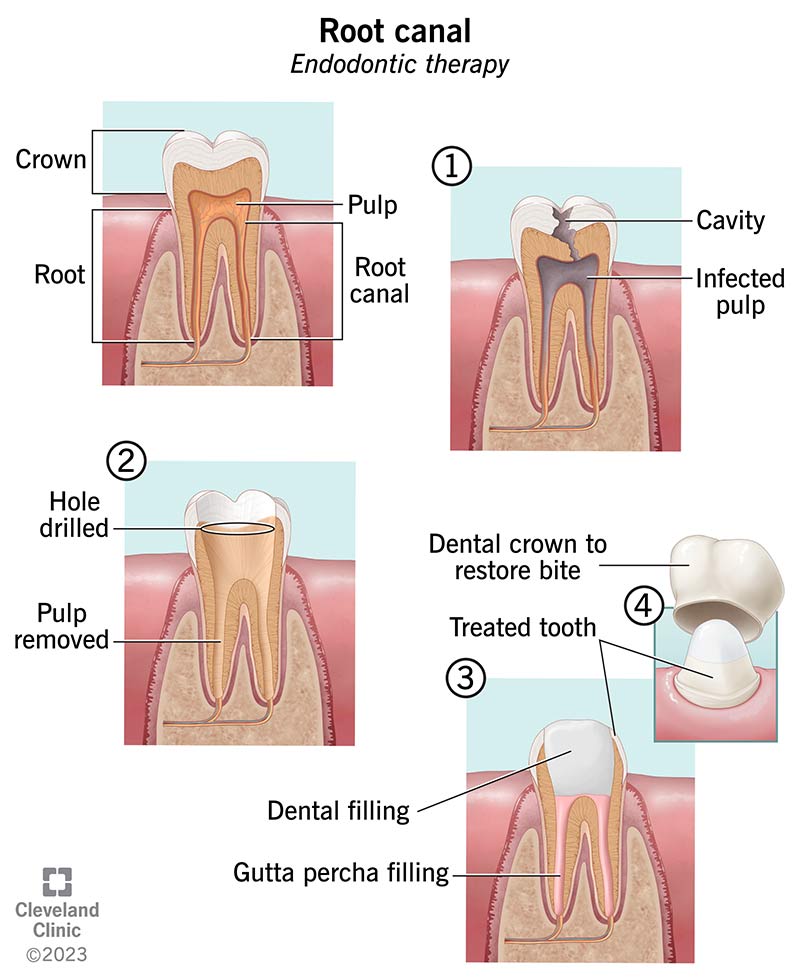A root canal clears infection from inside your tooth’s pulp, often resulting from deep cavities or cracks. If you notice pain, swelling or a boil on your gums, it could be time to see your dentist. Root canals are common and help save your natural tooth.
Advertisement
Cleveland Clinic is a non-profit academic medical center. Advertising on our site helps support our mission. We do not endorse non-Cleveland Clinic products or services. Policy

A root canal is a procedure that removes infected pulp from inside your tooth. Your dentist cleans and seals the canals to prevent further damage and save your tooth. You might need root canal treatment if bacteria reach the pulp and cause pain or inflammation.
Advertisement
Cleveland Clinic is a non-profit academic medical center. Advertising on our site helps support our mission. We do not endorse non-Cleveland Clinic products or services. Policy
This can happen if:
Root canals are common. Good oral hygiene can help you avoid needing one.
You might not notice an infected tooth at first, but root canal symptoms might include:
If you have root canal pain, don’t wait. Treatment can relieve pain, save your tooth and prevent the infection from spreading. Your dentist can help you decide if it’s the right option for you.
Before treatment, your provider will examine your tooth with X-rays and other tests to confirm the infection. They may:
Your dentist or endodontist will:
Advertisement
Most root canals take about 60 to 90 minutes. Some may require more than one visit.
You’ll rest briefly in the office after your procedure. You’ll likely have two more appointments: one to prepare for your crown and one to place it.
Most root canals are successful and can last for many years — often a lifetime. They can:
Sometimes, root canals don’t work if the damage is too severe. If that happens, your provider may:
Most people recover in less than a week. You might have some lingering sensitivity, but you shouldn’t have pain that lasts longer than that. If you do, call your provider.
Good care helps with root canal recovery. These simple steps can support your healing and help you avoid complications:
Thanks to modern anesthesia, root canals are usually no more painful than getting a filling. You may feel pressure during the procedure, and mild soreness afterward. Let your provider know if anything hurts — their goal is to keep you comfortable.
If your tooth hurts more after treatment — especially if the pain throbs — call your provider. You may still have infected pulp that needs attention.
Have a lingering toothache or feel pain when drinking something hot or cold? You might have an infected tooth. These infections won’t heal on their own, so it’s important to see a dentist. If you need a root canal, your provider will guide you through the process, so you know what to expect. To avoid root canals in the future, brush after meals, floss daily and get regular dental checkups.
Advertisement
Dentistry plays an important role in oral health. Cleveland Clinic’s experts can design a personalized plan that will keep you smiling for the long haul.

Last reviewed on 07/03/2025.
Learn more about the Health Library and our editorial process.